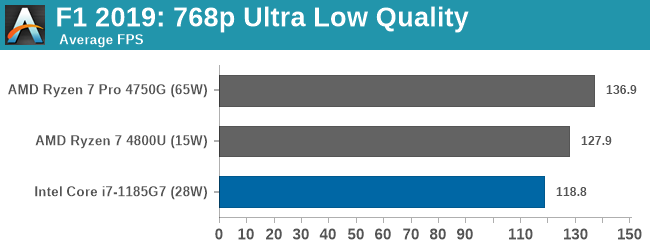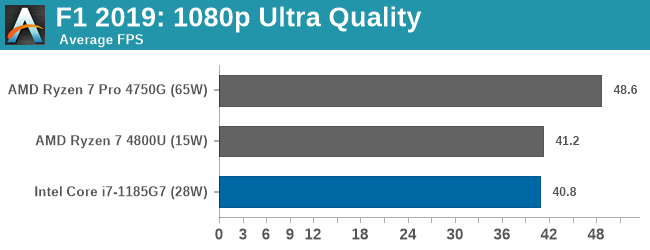Intel’s Tiger Lake 11th Gen Core i7-1185G7 Review and Deep Dive: Baskin’ for the Exotic
by Dr. Ian Cutress & Andrei Frumusanu on September 17, 2020 9:35 AM EST- Posted in
- CPUs
- Intel
- 10nm
- Tiger Lake
- Xe-LP
- Willow Cove
- SuperFin
- 11th Gen
- i7-1185G7
- Tiger King
Xe-LP GPU Performance: F1 2019
The F1 racing games from Codemasters have been popular benchmarks in the tech community, mostly for ease-of-use and that they seem to take advantage of any area of a machine that might be better than another. The 2019 edition of the game features all 21 circuits on the calendar, and includes a range of retro models and DLC focusing on the careers of Alain Prost and Ayrton Senna. Built on the EGO Engine 3.0, the game has been criticized similarly to most annual sports games, by not offering enough season-to-season graphical fidelity updates to make investing in the latest title worth it, however the 2019 edition revamps up the Career mode, with features such as in-season driver swaps coming into the mix. The quality of the graphics this time around is also superb, even at 4K low or 1080p Ultra.
To be honest, F1 benchmarking has been up and down in any given year. Since at least 2014, the benchmark has revolved around a ‘test file’, which allows you to set what track you want, which driver to control, what weather you want, and which cars are in the field. In previous years I’ve always enjoyed putting the benchmark in the wet at Spa-Francorchamps, starting the fastest car at the back with a field of 19 Vitantonio Liuzzis on a 2-lap race and watching sparks fly. In some years, the test file hasn’t worked properly, with the track not being able to be changed.
For our test, we put Alex Albon in the Red Bull in position #20, for a dry two-lap race around Austin.


In this case, at 1080p Ultra, AMD and Intel (28W) are matched. Unfortunately looking through the data, the 15 W test run crashed and we only noticed after we returned the system.











253 Comments
View All Comments
Spunjji - Friday, September 18, 2020 - link
Yet actual performance isn't as far apart as IPC alone would indicate, because the designs differ in some fundamental ways. It'll be interesting to see how this shakes out in practice.RedOnlyFan - Friday, September 18, 2020 - link
Lol you have got your info wrong. Sunny cove and willow cove IPC is more or less the same. Sunny cove is 18% higher IPC over skylake. Willow cove performance is higher because of higher clock ~20% more. It's impossible to define what's "sufficient".Rudde - Saturday, September 19, 2020 - link
From Spec2017: Willow Cove has 15% higher integer IPC and 12% higher floating point IPC compared to Zen 2. Zen 3 should be on par with Willow Cove on IPC. Golden Cove will of course keep a gap to Zen 3.zepi - Friday, September 18, 2020 - link
You should also publish the frequency vs. time graph for some of the tests. This would make it much easier to estimate how the chips scale with TDP.Sychonut - Friday, September 18, 2020 - link
For me personally, the real star of the show are those ARM processors (especially Apple's) performing so admirably at a smaller power envelope.abufrejoval - Friday, September 18, 2020 - link
For me the biggest motivator for getting one of these in a NUC would be to play with the shadow stack, control flow integrity (CFI) and memory encryption, because the ability to run secured corporate VMs on personal home-office hardware has a lot of appeal, even if it's originally a cloud issue.I'd obviously want those same features from AMD and wonder where they stand: Are their VM encryption mechanisms sufficiently similar to what Intel is pushing (would such things actually be covered under their intellectual property agreements)?
Any word on CFI from AMD? Or actual implementation of similar extensions on the ARM side?
vinay001 - Friday, September 18, 2020 - link
@Anandtech, What happened to 3080 review??Rudde - Saturday, September 19, 2020 - link
CA wildfiresandracass - Saturday, September 19, 2020 - link
The side ports on that reference model and the way the screen props the laptop up when you open it makes the device VERY reminiscent of the MSI Prestige.Like, identical.
Ian Cutress - Sunday, September 20, 2020 - link
It is. Intel initially asked the press not to put too much emphasis on the OEM they partnered with, as retail units will be different and more optimized. But a lot of press straight up mentioned it in their reviews, so I guess the cat is out of the bag.